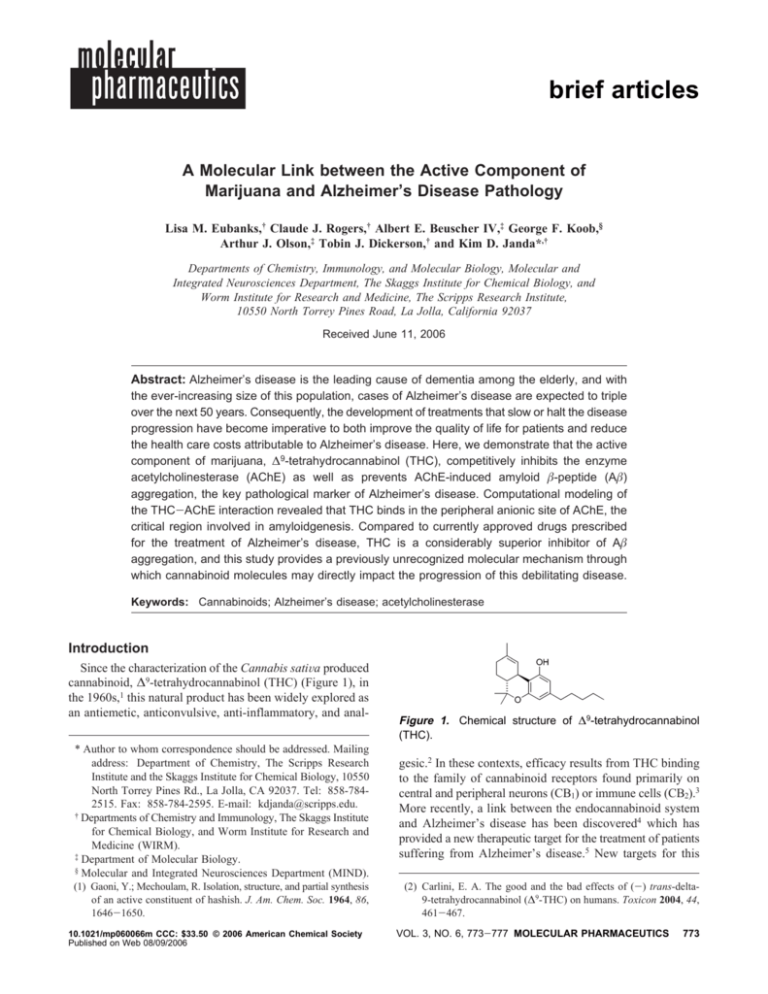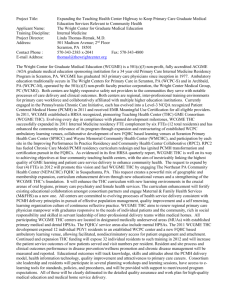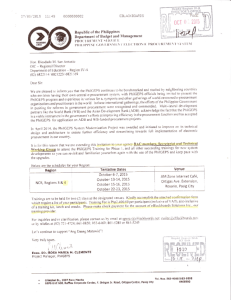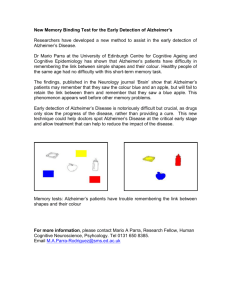A Molecular Link Between the Active Component of Marijuana and
advertisement

brief articles
A Molecular Link between the Active Component of
Marijuana and Alzheimer’s Disease Pathology
Lisa M. Eubanks,† Claude J. Rogers,† Albert E. Beuscher IV,‡ George F. Koob,§
Arthur J. Olson,‡ Tobin J. Dickerson,† and Kim D. Janda*,†
Departments of Chemistry, Immunology, and Molecular Biology, Molecular and
Integrated Neurosciences Department, The Skaggs Institute for Chemical Biology, and
Worm Institute for Research and Medicine, The Scripps Research Institute,
10550 North Torrey Pines Road, La Jolla, California 92037
Received June 11, 2006
Abstract: Alzheimer’s disease is the leading cause of dementia among the elderly, and with
the ever-increasing size of this population, cases of Alzheimer’s disease are expected to triple
over the next 50 years. Consequently, the development of treatments that slow or halt the disease
progression have become imperative to both improve the quality of life for patients and reduce
the health care costs attributable to Alzheimer’s disease. Here, we demonstrate that the active
component of marijuana, ∆9-tetrahydrocannabinol (THC), competitively inhibits the enzyme
acetylcholinesterase (AChE) as well as prevents AChE-induced amyloid β-peptide (Aβ)
aggregation, the key pathological marker of Alzheimer’s disease. Computational modeling of
the THC-AChE interaction revealed that THC binds in the peripheral anionic site of AChE, the
critical region involved in amyloidgenesis. Compared to currently approved drugs prescribed
for the treatment of Alzheimer’s disease, THC is a considerably superior inhibitor of Aβ
aggregation, and this study provides a previously unrecognized molecular mechanism through
which cannabinoid molecules may directly impact the progression of this debilitating disease.
Keywords: Cannabinoids; Alzheimer’s disease; acetylcholinesterase
Introduction
Since the characterization of the Cannabis satiVa produced
cannabinoid, ∆9-tetrahydrocannabinol (THC) (Figure 1), in
the 1960s,1 this natural product has been widely explored as
an antiemetic, anticonvulsive, anti-inflammatory, and anal-
Figure 1. Chemical structure of ∆9-tetrahydrocannabinol
(THC).
* Author to whom correspondence should be addressed. Mailing
address: Department of Chemistry, The Scripps Research
Institute and the Skaggs Institute for Chemical Biology, 10550
North Torrey Pines Rd., La Jolla, CA 92037. Tel: 858-7842515. Fax: 858-784-2595. E-mail: kdjanda@scripps.edu.
† Departments of Chemistry and Immunology, The Skaggs Institute
for Chemical Biology, and Worm Institute for Research and
Medicine (WIRM).
‡ Department of Molecular Biology.
§ Molecular and Integrated Neurosciences Department (MIND).
gesic.2 In these contexts, efficacy results from THC binding
to the family of cannabinoid receptors found primarily on
central and peripheral neurons (CB1) or immune cells (CB2).3
More recently, a link between the endocannabinoid system
and Alzheimer’s disease has been discovered4 which has
provided a new therapeutic target for the treatment of patients
suffering from Alzheimer’s disease.5 New targets for this
(1) Gaoni, Y.; Mechoulam, R. Isolation, structure, and partial synthesis
of an active constituent of hashish. J. Am. Chem. Soc. 1964, 86,
1646-1650.
(2) Carlini, E. A. The good and the bad effects of (-) trans-delta9-tetrahydrocannabinol (∆9-THC) on humans. Toxicon 2004, 44,
461-467.
10.1021/mp060066m CCC: $33.50 © 2006 American Chemical Society
Published on Web 08/09/2006
VOL. 3, NO. 6, 773-777 MOLECULAR PHARMACEUTICS
773
brief articles
debilitating disease are critical as Alzheimer’s disease afflicts
over 20 million people worldwide, with the number of
diagnosed cases continuing to rise at an exponential rate.6,7
These studies have demonstrated the ability of cannabinoids
to provide neuroprotection against β-amyloid peptide (Aβ)
toxicity.8-10 Yet, it is important to note that, in these reports,
cannabinoids serve as signaling molecules which regulate
downstream events implicated in Alzheimer’s disease pathology and are not directly implicated as effecting Aβ at a
molecular level.
One of the primary neuropathological hallmarks of Alzheimer’s disease is deposition of Aβ into amyloid plaques
in areas of the brain important for memory and cognition.11
Over the last two decades, the etiology of Alzheimer’s
disease has been elucidated through extensive biochemical
and neurobiological studies, leading to an assortment of
possible therapeutic strategies including prevention of downstream neurotoxic events, interference with Aβ metabolism,
and reduction of damage from oxidative stress and inflammation.12 The impairment of the cholinergic system is the
most dramatic of the neurotransmitter systems affected by
Alzheimer’s disease and, as a result, has been thoroughly
investigated. Currently, there are four FDA-approved drugs
that treat the symptoms of Alzheimer’s disease by inhibiting
(3) Howlett, A. C.; Barth F.; Bonner, T. I.; Cabral, G.; Casellas P.;
Devane, W. A.; Felder, C. C.; Herkenham, M.; Mackie, K.;
Martin, B. R.; Mechoulam, R.; Pertwee, R. G. International Union
of Pharmacology. XXVII. Classification of cannabinoid receptors.
Pharmacol. ReV. 2002, 54, 161-202.
(4) Benito, C.; Nunez, E.; Tolon, R. M.; Carrier, E. J.; Rabano, A.;
Hillard, C. J.; Romero, J. Cannabinoid CB2 receptors and fatty
acid amide hydrolase are selectively overexpressed in neuritic
plaque-associated glia in Alzheimer’s disease brains. J. Neurosci.
2003, 23, 11136-11141.
(5) Pazos, M. R.; Núñez, E.; Benito, C.; Tolón, R. M.; Romero, J.
Role of the endocannabinoid system in Alzheimer’s disease: new
perspectives. Life Sci. 2004, 75, 1907-1915.
(6) Ritchie, K.; Kildea, D. Is senile dementia “age-related” or “ageingrelated”?sevidence from meta-analysis of dementia prevalence
in the oldest old. Lancet 1995, 346, 931-934.
(7) Evans, D. A. Estimated prevalence of Alzheimer’s disease in the
United States. Milbank Q. 1990, 68, 267-289.
(8) Milton, N. G. Anandamide and noladin ether prevent neurotoxicity
of the human amyloid-β peptide. Neurosci. Lett. 2002, 332, 127130.
(9) Iuvone, T.; Esposito, R.; Santamaria, R.; Di Rosa, M.; Izzo, A.
A. Neuroprotective effect of cannabidiol, a non-psychoactive
component from Cannabis sativa, on beta-amyloid-induced toxicity in PC12 cells. J. Neurochem. 2004, 89, 134-141.
(10) Ramı́rez, B. G.; Blázquez, C.; Gómez del Pulgar, T.; Guzmán,
M.; de Ceballos, M. L. Prevention of Alzheimer’s disease
pathology by cannabinoids: neuroprotection mediated by blockade
of microglial activation. J. Neurosci. 2005, 25, 1904-1913.
(11) Rozemuller, J. M.; Eikelenboom, P.; Stam, F. C.; Beyreuther, K.;
Masters, C. L. A4 protein in Alzheimer’s disease: primary and
secondary cellular events in extracellular amyloid deposition. J.
Neuropathol. Exp. Neurol. 1989, 48, 674-691.
(12) Bachurin, S. O. Medicinal chemistry approaches for the treatment
and prevention of Alzheimer’s disease. Med. Res. ReV. 2003, 23,
48-88.
774
MOLECULAR PHARMACEUTICS VOL. 3, NO. 6
Eubanks et al.
the active site of acetylcholinesterase (AChE), the enzyme
responsible for the degradation of acetylcholine, thereby
raising the levels of neurotransmitter in the synaptic cleft.13
In addition, AChE has been shown to play a further role in
Alzheimer’s disease by acting as a molecular chaperone,
accelerating the formation of amyloid fibrils in the brain and
forming stable complexes with Aβ at a region known as the
peripheral anionic binding site (PAS).14,15 Evidence supporting this theory was provided by studies demonstrating that
the PAS ligand, propidium, is able to prevent amyloid
acceleration in vitro, whereas active-site inhibitors had no
effect.16 Due to the association between the AChE PAS and
Alzheimer’s disease, a number of studies have focused on
blocking this allosteric site.17 Recently, we reported a
combined computational and experimental approach to
identify compounds containing rigid, aromatic scaffolds
hypothesized to disrupt protein-protein interactions.18-20
Similarly, THC is highly lipophilic in nature and possesses
a fused tricyclic structure. Thus, we hypothesized that this
terpenoid also could bind to the allosteric PAS of AChE with
concomitant prevention of AChE-promoted Aβ aggregation.
Experimental Section
Docking Procedures. THC was docked to the mouse
AChE structure (PDB ID code 1J07) using AutoDock 3.0.5.21
Twenty docking runs (100 million energy evaluations each)
were run with a 26.25 Å × 18.75 Å × 26.25 Å grid box
(13) Racchi, M.; Mazzucchelli, M.; Porrello, E.; Lanni, C.; Govoni,
S. Acetylcholinesterase inhibitors: novel activities of old molecules. Pharmacol. Res. 2004, 50, 441-451.
(14) Inestrosa, N. C.; Alvarez, A.; Pecez, C. A.; Moreno, R. D.;
Vicente, M.; Linker, C.; Casanueva, O. I.; Soto, C.; Garrido, J.
Acetylcholinesterase accelerates assembly of amyloid-β-peptides
into Alzheimer’s fibrils: possible role of the peripheral site of
the enzyme. Neuron 1996, 16, 881-891.
(15) Alvarez, A.; Alarcon, A.; Opazo, C.; Campos, E. O.; Munoz, F.
J.; Calderon, F. H.; Dajas, F.; Gentry, M. K.; Doctor, B. P.; De
Mello, F. G.; Inestrosa, N. C. Stable complexes involving
acetylcholinesterase and amyloid-β peptide change the biochemical properties of the enzyme and increase the neurotoxicity of
Alzheimer’s fibrils. J. Neurosci. 1998, 18, 3213-3223.
(16) Bartolini, M.; Bertucci, C.; Cavrini, V.; Andrisano, V. β-Amyloid
aggregation induced by human acetylcholinesterase: inhibition
studies. Biochem. Pharmacol. 2003, 65, 407-416.
(17) Johnson, G.; Moore, S. W. The peripheral anionic site of
acetylcholinesterase: structure, functions and potential role in
rational drug design. Curr. Pharm. Des. 2006, 12, 217-225.
(18) Dickerson, T. J.; Beuscher, A. E., IV; Rogers, C. J.; Hixon, M.
S.; Yamamoto, N.; Xu, Y.; Olson, A. J.; Janda, K. D. Discovery
of acetylcholinesterase peripheral anionic site ligands through
computational refinement of a directed library. Biochemistry 2005,
44, 14845-14853.
(19) Xu, Y.; Shi, J.; Yamamoto, N.; Moss, J. A.; Vogt, P. K.; Janda,
K. D. A credit-card library approach for disrupting protein-protein
interactions. Bioorg. Med. Chem. 2006, 14, 2660-2673.
(20) Xu, Y.; Lu, H.; Kennedy, J. P.; Yan, X.; McAllister, L. A.;
Yamamoto, N.; Moss, J. A.; Boldt, G. E.; Jiang, S.; Janda, K. D.
Evaluation of “credit card” libraries for inhibition of HIV-1 gp41
fusogenic core formation. J. Comb. Chem. 2006, 8, 531-539.
brief articles
Marijuana and Alzheimer’s Disease Pathology
with 0.375 Å grid spacing. This grid box was designed to
include regions of both the catalytic site and the peripheral
anionic site. Otherwise, standard docking settings were used
for the AutoDock calculations, as previously detailed.18
Acetylcholinesterase Inhibition Studies. All assays were
performed using a Cary 50 Bio UV-visible spectrophotometer using an 18-cell changer, and conducted at 37 °C, using
a Cary PCB 150 water Peltier system. Solutions of acetylthiocholine iodide (ATCh iodide) and 5,5′-dithiobis(2nitrobenzoic) acid (DTNB) were prepared according to the
method of Ellman et al.22 Stock solutions of acetylcholinesterase from Electrophorus electricus were prepared by
dissolving commercially available enzyme in 1% gelatin.
Prior to use, an aliquot of the gelatin solution was diluted
1:200 in water. For the assay, the solution was diluted until
enzyme activity between 0.1 and 0.13 AU/min at 500 µM
ACTh iodide was obtained. Compounds were prepared as
solutions in methanol.
Assays were performed by mixing AChE, THC, and 340
µM DTNB in 100 mM phosphate buffer, pH 8.0, containing
5% methanol. Solutions were incubated at 37 °C for 5 min
before the reaction was initiated by the addition of ATCh
iodide (75-300 µM). The increase of absorbance at 412 nm
was monitored for 2-5 min. All assays were run in triplicate.
Initial rates were determined by subtracting the average
observed initial rate from the nonenzymatic reaction.
Linear regression analysis of reciprocal plots of 1/Vo versus
1/[S] for four THC concentrations was performed using
Microsoft Excel software. The slope was plotted against [I]
to give Ki values. Propagation of error was performed to
determine the error, ∆Ki.
For studies to determine the mutual exclusivity of THC
and propidium iodide, experiments were performed identically to THC inhibition studies with a fixed concentration
of ACTh iodide (125 µM), and varied concentrations of
propidium iodide (0-25 µM) and THC (0-15 µM).
AChE-Induced β-Amyloid Peptide Aggregation in the
Presence of AChE Ligands. The aggregation of the β-amyloid peptide was measured using the thioflavin T based
fluorometric assay as described by LeVine23 and Bartolini.16
Assays were measured using a SpectraMAX Gemini fluorescence plate reader with SOFTmax PRO 2.6.1 software.
Aβ1-40 stock solutions were prepared in DMSO and HuAChE
stocks prepared in distilled water. All stock solutions of Aβ
and HuAChE were used immediately after preparation.
In a 96-well plate, triplicate samples of a 20 µL solution
of 23 nM Aβ, 2.30 µM HuAChE, and various concentrations
(21) Morris, G. M.; Goodsell, D. S.; Halliday, R. S.; Huey, R.; Hart,
W. E.; Belew, R. K.; Olson, A. J. Automated docking using a
Lamarckian genetic algorithm and an empirical binding free
energy function. J. Comput. Chem. 1998, 19, 1639-1662.
(22) Ellman, G. L.; Courtney, K. D.; Andres, Jr., V.; Featherstone, R.
M. A new and rapid colorimetric determination of acetylcholinesterase activity. Biochem. Pharmacol. 1961, 7, 88-95.
(23) LeVine, H., III. Thioflavine T interaction with synthetic Alzheimer’s disease β-amyloid peptides: detection of amyloid
aggregation in solution. Protein Sci. 1993, 2, 404-410.
Figure 2. Predicted binding mode of THC (gray) to AChE
(orange ribbon). The catalytic triad residues of AChE (green)
and water molecules included in the docking calculations (light
blue spheres) are shown.
of THC in 0.215 M sodium phosphate buffer, pH 8.0, were
prepared. These solutions were incubated at room temperature along with triplicate solutions of Aβ alone, Aβ with
AChE, and Aβ with varying concentrations of THC. After
48 h, a 2 µL aliquot was removed from each well, placed in
a black-walled, clear-bottomed 96-well plate, and diluted
with 50 mM glycine-NaOH buffer, pH 8.5, containing 1.5
µM thioflavin T to a total volume of 200 µL. After incubation
for 5 min, the fluorescence was measured using λexc ) 446
nm and λem ) 490 nm with excitation and emission slits of
2 nm. The fluorescence emission spectrum was recorded
between 450 and 600 nm, with excitation at 446 nm.
The fluorescence intensities were averaged, and the
average background fluorescence of buffer only, or buffer
and THC, was subtracted. The corrected fluorescence values
were plotted with their standard deviation. The equation, Fi/
Fo × 100%, where Fi is the fluorescence of AChE, Aβ, and
THC, and Fo is the fluorescence of AChE and Aβ, was used
to quantify the extent to which each compound inhibits Aβ
aggregation. The Student’s t-test function of Microsoft Excel
was used to determine p values and assess statistical
significance between reactions.
Control experiments containing AChE, THC, and thioflavin T or AChE and thioflavin T alone were also performed
to ensure that any observed fluorescence decrease was not
attributable to the molecular rotor properties of thioflavin T
upon binding to AChE. For these reactions, all concentrations
were identical to those used in the described Aβ aggregation
assays (vide supra).
Results and Discussion
THC binding to AChE initially was modeled in silico using
AutoDock 3.0.5.21 Twenty docking runs with 100 million
energy evaluations each were performed with a 26.25 Å ×
18.75 Å × 26.25 Å grid box with 0.375 Å grid spacing,
which included regions of both the catalytic site and the PAS.
Examination of the docking results revealed that THC was
VOL. 3, NO. 6 MOLECULAR PHARMACEUTICS
775
brief articles
Eubanks et al.
Figure 3. (A) Kinetic analysis of AChE inhibition by THC: 0 (b), 6.25 (2), 12.5 ([), and 25.0 µM (9). Steady-state kinetic
analysis was performed using acetylthiocholine (75-300 µM) and Ellman’s reagent (340 µM) at 37 °C. (B) Dixon plots of 1/v
versus [THC] at different fixed concentrations of propidium iodide: 0 (b), 6.25 (2), 12.5 ([), and 25 µM (9).
predicted to bind to AChE with comparable affinity to the
best reported PAS binders, with the primary binding interaction observed between the ABC fused ring of the THC
scaffold and the Trp86 indole side chain of AChE (Figure
2). Further interactions were also evident between THC and
the backbone carbonyls of Phe123 and Ser125. Encouraged
by these results, we tested the ability of THC to inhibit AChE
catalytic activity. Steady-state kinetic analysis of THC
inhibition revealed that THC competitively inhibits AChE
(Ki ) 10.2 µM) (Figure 3A). This level of inhibition is
relatively modest, yet it is important to note that inhibition
of acetylcholine cleavage is not a prerequisite for effective
reduction of Aβ aggregation; indeed, most PAS binders are
moderate AChE inhibitors displaying either noncompetitive
or mixed-type inhibition.16 While THC shows competitive
inhibition relative to the substrate, this does not necessitate
a direct interaction between THC and the AChE active site.
In fact, given the proximity of the PAS to the protein channel
leading to the catalytic triad active site, it is possible to block
substrate entry into the active site while bound to the PAS,
thus preventing the formation of an ESI complex.18,24 In order
to test this hypothesis, additional kinetic experiments were
performed to determine the mutual exclusivity of THC and
propidium, a well-characterized purely noncompetitive AChE
inhibitor and PAS binder. Dixon plots of V-1 versus THC
concentration at different fixed concentrations of propidium
returned a series of parallel lines, indicating that THC and
propidium cannot bind simultaneously to AChE (Figure 3B).
Thus, these studies verify our docking results and demonstrate that THC and propidium are mutually exclusive PAS
inhibitors. Additionally, recent reports have suggested that
the selectivity of a given inhibitor for AChE over butyryl(24) Szegletes, T.; Mallender, W. D.; Rosenberry, T. L. Nonequilibrium
analysis alters the mechanistic interpretation of inhibition of
acetylcholinesterase by peripheral site ligands. Biochemistry 1998,
37, 4206-4216.
776
MOLECULAR PHARMACEUTICS VOL. 3, NO. 6
cholinesterase (BuChE) can be correlated with the ability of
a compound to block AChE-accelerated Aβ aggregation.25,26
Kinetic examination of BuChE inhibition revealed a slight
reduction in enzymatic activity at high concentrations of THC
(IC50 g 100 µM); however, these experiments were limited
by the poor solubility of THC in aqueous solution.
The activity of THC toward the inhibition of Aβ aggregation was then investigated using a thioflavin T (ThT) based
fluorometric assay to stain putative Aβ fibrils.23 Using this
assay, we found that THC is an effective inhibitor of the
amyloidogenic effect of AChE (Figure 4). In fact, at a
concentration of 50 µM, propidium does not fully prevent
AChE-induced aggregation (p ) 0.03, Student’s t test), while
THC completely blocks the AChE effect on Aβ aggregation,
with significantly greater inhibition than propidium (p )
0.04, Student’s t test), one of the most effective aggregation
inhibitors reported to date.16 However, the observed decrease
in fluorescence could also be rationalized as a result of a
competition between THC and ThT for the same site on
AChE. It has been shown that ThT also can bind to the PAS
and that this binding leads to an increase in fluorescence.
Presumably, this phenomenon results from ThT serving as
a molecular rotor in which fluorescence quantum yield is
sensitive to the intrinsic rotational relaxation; thus, when
molecular rotation is slowed by protein binding, the quantum
(25) Piazzi, L.; Rampa, A.; Bisi, A.; Gobbi, S.; Belluti, F.; Cavalli,
A.; Bartolini, M.; Andrisano, V.; Valenti, P.; Recanatini, M. 3-(4{[Benzyl(methyl)amino]methyl}-phenyl)-6,7-dimethoxy-2H-2chromenone (AP2238) inhibits both acetylcholinesterase and
acetylcholinesterase-induced β-amyloid aggregation: A dual
function lead for Alzheimer’s disease therapy. J. Med. Chem.
2003, 46, 2279-2282.
(26) Belluti, F.; Rampa, A.; Piazzi, L.; Bisi, A.; Gobbi, S.; Bartolini,
M.; Andrisano, V.; Cavalli, A.; Recanatini, M.; Valenti, P.
Cholinesterase inhibitors: Xanthostigmine derivatives blocking
the acetylcholinesterase-induced β-amyloid aggregation. J. Med.
Chem. 2005, 48, 4444-4456.
brief articles
Marijuana and Alzheimer’s Disease Pathology
AChE, THC, and ThT. Reactions containing AChE and ThT
alone showed the same fluorescence output as those containing AChE, THC, and ThT, providing convincing evidence
that any observed reduction in fluorescence can be attributed
to fewer Aβ fibrils.
Conclusion
Figure 4. Inhibition of AChE-induced Aβ aggregation by THC
and propidium ((*) p < 0.05 versus Aβ only; (#) p < 0.05
versus Aβ + propidium).
yield of the molecule can increase dramatically.27,28 In order
to ensure that the observed fluorescence decrease was due
to fibril inhibition, control experiments were performed using
(27) De Ferrari, G. V.; Mallender, W. D.; Inestrosa, N. C.; Rosenberry,
T. L. Thioflavin T is a fluorescent probe of the acetylcholinesterase
peripheral site that reveals conformational interactions between
the peripheral and acylation sites. J. Biol. Chem. 2001, 276,
23282-23287.
(28) Viriot, M. L.; Carre, M. C.; Geoffroy-Chapotot, C.; Brembilla,
A.; Muller, S.; Stoltz, J. F. Molecular rotors as fluorescent probes
for biological studies. Clin. Hemorheol. Microcirc. 1998, 19, 151160.
We have demonstrated that THC competitively inhibits
AChE and, furthermore, binds to the AChE PAS and
diminishes Aβ aggregation. In contrast to previous studies
aimed at utilizing cannabinoids in Alzheimer’s disease
therapy,8-10 our results provide a mechanism whereby the
THC molecule can directly impact Alzheimer’s disease
pathology. We note that while THC provides an interesting
Alzheimer’s disease drug lead, it is a psychoactive compound
with strong affinity for endogenous cannabinoid receptors.
It is noteworthy that THC is a considerably more effective
inhibitor of AChE-induced Aβ deposition than the approved
drugs for Alzheimer’s disease treatment, donepezil and
tacrine, which reduced Aβ aggregation by only 22% and 7%,
respectively, at twice the concentration used in our studies.7
Therefore, AChE inhibitors such as THC and its analogues
may provide an improved therapeutic for Alzheimer’s
disease, augmenting acetylcholine levels by preventing
neurotransmitter degradation and reducing Aβ aggregation,
thereby simultaneously treating both the symptoms and
progression of Alzheimer’s disease.
Acknowledgment. This work was supported by the
Skaggs Institute for Chemical Biology and a NIH Kirschstein
National Research Service Award to L.M.E.
MP060066M
VOL. 3, NO. 6 MOLECULAR PHARMACEUTICS
777








